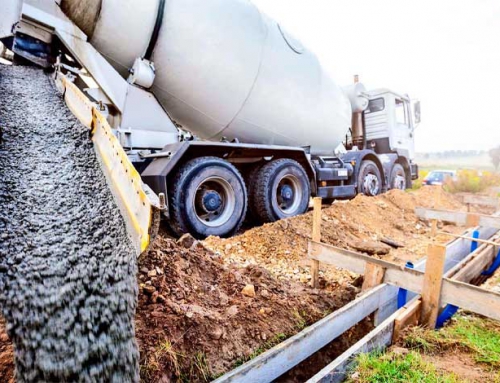What Is Hydration?
When cement, water, aggregates and admixtures are blend together, a significant increase in temperature occurs. This is due to the exothermic process in the reaction between cement and water, which is called hydration. Measuring the temperature of concrete over time enables us to know the effect of hydration so that we can estimate the strength of concrete. Because of the importance of this topic, we will talk about guidance in detail in this article.
Definition of Hydration
Hydration is a series of chemical reactions that occur as a result of a collision between water and hydraulic cement. When water and cement combine in the cement paste, most of the cement grains immediately begin to dissolve in the water, which initiates the hydration process.
These reactions produce new compounds, and the more hydrated the cement, the more water and cement are consumed and the more compounds are produced. The compounds expand and also begin to pile up and bind together.
Finally, the accumulation of compounds leads to stiffing, hardening and development of cement paste strength, making plastic concrete a resistant and durable product; but concrete hydration is not just a combination of cement and water! The amount of hydration of cement depends on various factors, which we will discuss in the following article.
Cement Hydration Compounds
The main products of cement hydration reactions are calcium silicate hydrate (CSH), calcium hydroxide (CH) and the AFt and AFm phases. The AFt and AFm phases in hydrated cement are C3A, anhydrite and water. Hydrated Portland cement paste usually consists of about 50% CSH by mass and about 15% to 25% CH. Most of the resistance shown by hydrated cement paste, especially resistance, can be attributed to CSH.
C3A is reactive among the four major mineral phases of cement, but only slightly increases the initial strength. C3A reacts simply with the water in the cement paste to produce an aluminate-rich gel that releases a significant amount of heat.
The heat generated decreases quickly and usually lasts only a few minutes. The resulting gel, however, reacts with various sulfates in cement, including plaster, anhydrite, and hemihydrates, to produce ettringite. The development of ettringite in the early stages of hydration will help control the hardening of plastic concrete. Days after hydration, ettringite is gradually consumed by reaction with C3A and replaced with monosulfate.
C3S and water react to produce CSH and CH. C3S, also called alite, hydrates rapidly and reacts and hardens, making the greatest contribution to the initial set of concrete and the development of initial strength. C2S also reacts with water to form CSH and CH. However, C2S or belite reacts slowly to alite, and in turn a major factor in increasing concrete strength is over one week of age.
What is the hydration process like?
The initial reaction occurs after the cement and water are mixed and the temperature peak occurs. Aluminate (C3A) reacts with H2O (calcium and sulfate ions) to form etheringite (aluminate hydrate). The release of energy from these reactions causes the peak of initial setting of concrete. The result of this reaction is the surface coating of cement particles. This coating will reduce the reaction rate because access to H2O is not as good as the mixing time of concrete. This phase is used to transfer concrete and concrete placement.

In the next step, the increase in heat is because of the reaction between calcium silicate (C3S and C2S), which causes the hydration of CSH silicate. The formation of silicate hydrate also has a major effect on the strength of concrete in secondary setting. Monitoring the internal temperature of concrete can be very important because the temperature of concrete at this stage can rise rapidly to a temperature of about 70 to 80 degrees Celsius.
Then the maximum temperature is obtained and the availability of free particles is reduced, and consequently this also reduces the temperature velocity. This stage often ends with good resistance and now the formwork around the concrete can be opened. The hydration process will now slow down and continue slowly as the particles in the cement and water continue to react, until the strength of the concrete reaches its maximum.
Effects of temperature on hydration
The rate of hydration increases with increasing temperature and as a result the time decreases. Above 230°F (110°C), the hydration products formed are significantly different from those obtained at low temperatures. Alite and ticket phases are hydrated to obtain crystallized α-C2SH instead of amorphous C-S-H
α-C2SH is a crystalline and relatively dense material and is harmful because of its high permeability and low compressive strength. By adding finely ground silica such as silica flour to cement, α-C2SH formation can be prevented or minimized.
Ambient temperature during mixing, concrete placement and curing of concrete plays a role in hydration of cement. Although not all cements react in the same way, the setting time usually decreases with increasing temperature.
As a rule, a fluctuation of 10 degrees Fahrenheit can change about 33% of the setting time. The ideal baking temperature typically varies from 50 to 70 degrees. Temperatures below 50 degrees promote hydration at a much slower rate; when the temperature drops below 40 degrees, the growth of the initial resistance decreases significantly.
In spite of that, when the ambient temperature exceeds 70 degrees, hydration becomes too rapid and can lead to harmful results such as cracking and shrinkage of the plastic, lower 28-day resistance and lowering of the temperature. Mixed water temperature also plays an important role in hydration because it changes the temperature of concrete. The temperature of the water in the mixture can be adjusted, often by heating the water or adding ice to the water.
The role of processing techniques in hydration
Excess moisture during processing can replace water lost due to hydration and evaporation. With the addition of excess moisture, the amount of hydration is largely ineffective. However, it is important to ensure that sufficient moisture is present during hydration and processing.

Poor moisture can cause the cement to become dehydrated and have no beneficial properties for the concrete or premature drying of the concrete, and can even lead to cracking of a small surface. Excess moisture can be applied through sack wetting, daily watering and other methods.
Moisture retention methods depend on nylon, coatings, or membrane-forming compounds applied to the outer surface of the concrete to trap moisture. Moisture retention has little effect on hydration. Instead, maintenance methods help to improve the processing environment by ensuring that there is sufficient moisture for hydration.
Rapid curing using heat and steam increases the rate of hydration and the rate of development of concrete strength. Rapid recovery is especially useful in achieving initial resistance. These methods are frequently used in concrete placement in cold weather to create a more suitable environment for hydration of cement.
Internal processing involves the use of lightly saturated aggregates, which help maintain sufficient moisture in the concrete by providing an internal source of water supply. Internal processing has little effect on hydration and helps to create a favorable environment for hydration. Internal humidity treatment is often used for a variety of concretes that contain high amounts of cementitious materials.
The role of admixtures in hydration
The accelerator offers options to increase the water supply, increase the initial strength and reduce the initial setting time, which is often important to the durability of the concrete. By accelerating the barrier around the cement particles, the accelerators allow water to more easily access the C3S and C2S phases, thus increasing the hydration of the minerals.
Accelerators are often used to compensate for the effects of lag in the setting of concrete in cold weather. Conversely, admixtures reduce the rate of hydration and increase the initial strength by delaying setting, and will increase the duration of the initial and final setting.
Inhibitors slow down hydration by preventing the formation and growth of some hydration products. They are usually used to offset the rapid cooking speed due to hot weather or adjusted latency to use special finishing techniques or difficult placement situations.
Accelerators and anti-setting admixtures are both available in different forms but often appear as liquid chemical admixtures. How these admixtures work depends on the composition, dose, time and order of their addition to the mixture, as well as the ambient temperature and the temperature of the concrete.
For complete hydration of cement, typically 0.4 compounds, water is required. The amount of hydration of the ingredients depends on several factors. However, if the water to cement ratio is too high, excess water will remain in the concrete matrix. Excess water remains until evaporation, which in addition to not contributing to compressive strength, increases the susceptibility of concrete to cracking.
Conversely, if the water to cement ratio is too low, the mixed water is consumed or evaporated while the cement remains waterless in the matrix. This has no benefit for the strength and durability of concrete! Supplementary cementitious materials (SCM) are often added as a substitute for Portland cement in concrete mixes. Supplementary cementitious materials exhibit the same behavior as traditional cement
However, different types of supplementary cementitious materials enhance or inhibit some of the water supply measures. Commonly used cementitious materials include fly ash, silica fume, and blast furnace slag, which like fly ash and slag cement, reduce the heat of hydration of concrete and increase setting time. While some natural pozzolans such as calcite or clay and metakaolin reduce the heat of hydration, they have no effect on setting time.
The last word
Hydration should be considered as the most important stage of concrete production. This step affects the strength, durability and all properties of concrete. Hydration of cement depends on the ambient temperature, water to cement ratio, type of cement and other factors. In general, for the production of concrete, it is important that engineers are aware of the hydration process and the factors affecting it.
Sources :










Leave A Comment